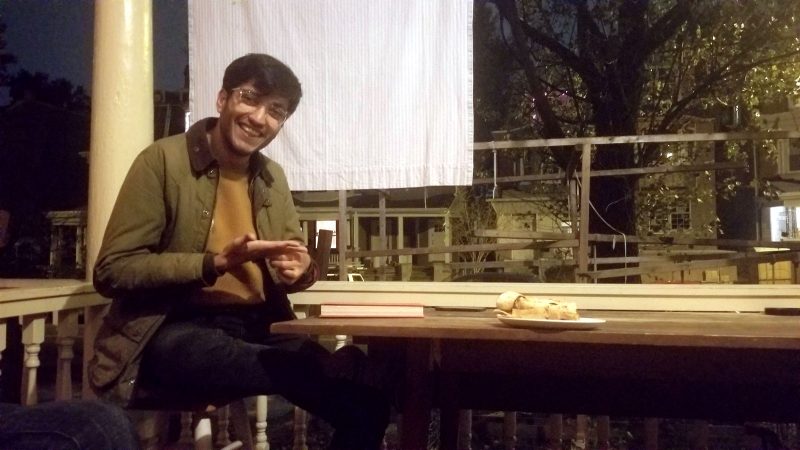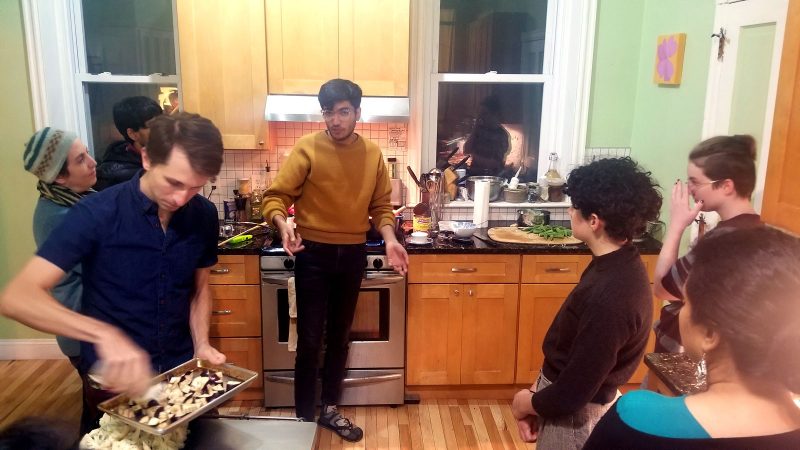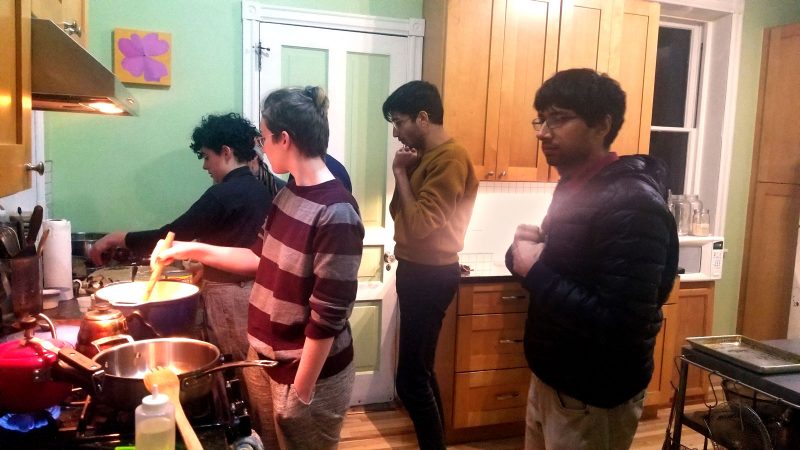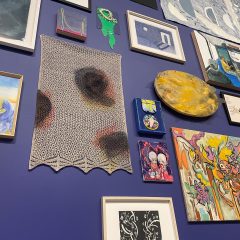
Immigrant Kitchen begins on the porch of a West Philadelphia home. As participants arrive, the performer, Shreshth Khilani, sits and makes casual conversation with everyone. A plate of papad sits on a table and is offered to everyone. Khilani jokes, “This is the only food you don’t have to cook tonight.” That is because for Immigrant Kitchen, the audience is responsible for cooking a meal that will be shared by all at the show’s end.
Khilani is a gentle guide throughout the night, telling stories of their adolescence in India while also offering instruction on how to make a Sindhi meal. The invitation for Immigrant Kitchen promises, “a space of safety and intimacy for queer and other marginalized people to feel welcome, heard, and fed (metaphorically, and literally).” Creating this space is a task that the artist tackles with passion — to emotional and gustatory success. I spoke with Shreshth Khilani to learn more how such an unusual performance piece came to be.
Logan Cryer: What does Immigrant Kitchen mean to you personally and what do you want your audience to take away with them?
Shreshth Khilani: Immigrant Kitchen is a way for me to come out to the world. I remember my family having dinners, before group text existed, as a way to call relatives and friends over to make a big announcement. I feel like Immigrant Kitchen is a way to make my announcement. As with all family announcement dinners, you have a script of what you want to say and you know what questions people will ask and how to respond to those questions. That’s what it feels like right now to me.
There’s many things I want the show to be. I want it to be a chance for someone to learn how to cook, to be okay with being in a kitchen, to be watching theatre in a space that isn’t a theater. I want them to be in the presence of an energy that is not masculine, I want people to take away things that are very specific culturally and also very specific in terms of my gender identity and relate them back to their own culture, identity, and experiences.
LC: What about Immigrant Kitchen, as a performance, lends itself to meaningful connection?
SK: There is a two way conversation occurring during the show. This performance isn’t me standing at a proscenium, talking at you. I can be vulnerable and tell stories, and then people sometimes are influenced enough to share stories of their own. Specifically, when queer people and people of color come listen to me share these stories about my life, I think it makes it easier for them to talk about their lives.
I really love cooking for people and really love performing for people; these are all acts of service in a way. How could you ever serve without empowering in some way? How could you ever serve without giving voice?
LC: Have you had any particularly memorable responses from audience members?
SK: Last weekend someone mentioned to me that he also grew up in India and that he has these memories of his mother not participating at the dinner table because she was making rotis, fresh, for everyone. The joy of eating rotis is eating them warm and fresh so, she’s bringing them and people are eating them while she’s making them. Only after the family has eaten most of the meal already will she come and sit with everyone else. My mother did the same thing.
The bread made during the show is designed to be one big piece that we can all break into smaller pieces and bake in the oven at once. That is not how Indians eat it, but this person told me he was going to make bread this way from now on. It may not be as delicious but, it still tastes like home and it takes away some of the manual process that my mother had to be excluded from the dinner table for.
One show had a twelve-year-old who knew the Hindu mythology I was telling. She was like, “Oh! I read this book about this.” That’s really what this is about. It’s important for me to be specific but also to make that specificity accessible to other people in a way that doesn’t subtract from the culture itself.

LC: You’ve talked in the past about America’s reluctance to put a high cultural and monetary value on certain foods, particular made by working class immigrants. How does your show address that ?
SK: Immigrant Kitchen is donation only and you donate at the end, after we’ve eaten, without me looking at you — its all like self-motivated. I have a grant from the Leeway Foundation which is really helpful in making that happen. Otherwise I would be made to pay for it on my own or put a price value on the food. The meal we eat, I think is really good but, I don’t think it would attract as many people if they had to pay $20 for it.
There is a culture of, “This is Chinese food, this is Indian food, this should cost less money.” Corner Chinese restaurants are often the cheapest places for people to eat for example. I don’t think I can change that just with one show but I do try to create an atmosphere where people can understand that the value of this meal is so much more than they may think. There are generations of thought that goes into it. Recipes are passed down through generations.
LC: Can you talk a little about your work leading up to Immigrant Kitchen?
SK: I wrote, directed, and performed in a piece, Table on Table on Table, about queerness and about an immigrant feeling stuck choosing between their queerness and serving their family. Table on Table on Table was a radio play you listened to while you experienced a dance performance. It took place in an attic — bodies moved around you and objects moved around you and the lights turned off and on around you. That was a very exciting piece.
I’ve also worked on another food performance this year, CHEZ VOUS!. It was an anonymous show at Digital Fringe that people could sign up for. The premise was this ridiculous claim that Jeremy Cohen, my co-creator, and I were part of this TV show that brought chefs (Jeremy and I) to cook a meal from the ingredients in your own kitchen. It was a silly thing of trying to explore what type of person would invite these random strangers to their home. We went to ten homes and were excited to cook for these people. We interacted with them and had interesting conversations. With some people we formed bonds but other felt more distant.
Both CHEZ VOUS! and Immigrant Kitchen ask, how can we bring people together with food and how can food and performance come together? I often joke that there are as many people who are really skeptical about this being performance as there are people who are excited about this being performance.
LC: What are the advantages of doing theater outside of a traditional context?
SK: I don’t need to wait for someone to bestow upon me the ability to make work. My time at Headlong Performance Institute, run by Amy Smith and David Brick, was very influential in encouraging the idea that performance doesn’t have to live in a theater. Jungwoong Kim is another artist who embodies that.
I was talking to Amy the other day about how people are more interested in attending shows that can give them something that Netflix can’t. Like, if I’m sitting at home and I’m watching Netflix or I’m sitting and watching a show at a regional theater, how much different are those things? I think that inviting you to my kitchen is something that if I was making work for Netflix, I couldn’t do. If I was making work for the theater I couldn’t do it either.
LC: What has surprised you in the process of performing Immigrant Kitchen?
SK: People speaking to me about their experiences has been really touching. It’s just really cool that I can get these responses from people, whether it be an email or volunteering a story of their own during the show. That kind of community building is something that theoretically I knew would happen but actually experiencing it surprising and reminds me why I’m doing this. It definitely feels good.
“Immigrant Kitchen” is created and performed by Shreshth Khilani and directed by Jeremy Cohen. Performances are October 28 – December 3, 2018. More details are on the Facebook event page. You can reserve a (free) ticket here.










